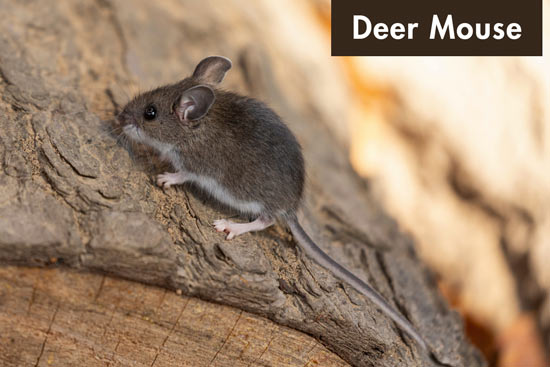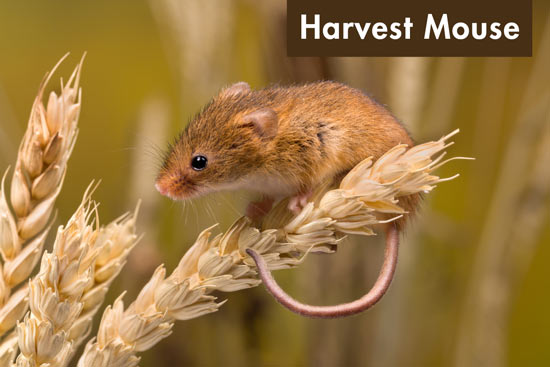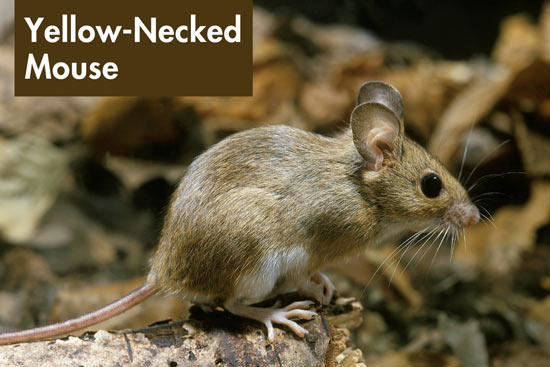Different Types of Mice | 14 Mouse Species With Pictures
Mouse is a common word we have heard since our childhood. We have seen it running around in our homes, gardens, and streets. But that’s just one species of mouse i.e., “house mouse”. In reality, there are many types of mice in the world with diverse characteristics and behaviors. Their way of living is different and they also act differently. Some live in the wild, while others live near our homes. But all of them are little, quick, and fluffy.
There can be a little confusion between mice and rats. They’re both rodents, but they’re different in some ways. Size is one of the easiest ways to identify them. Rats are heavier and bigger than mice. Overall, they both are different species. Let’s take a closer look at the different kinds of mice.
Table of Contents
Types of Mice
Every region has its own native mouse species. Some common breeds of mice include the house mouse, deer mouse, field mouse, wood mouse, white-footed mouse, etc. Below we will discuss each one of them in detail:
White-Footed Mice
Scientific Name: Peromyscus leucopus
White-footed mice come from North America. You can also find them in places like Ontario, Quebec, and Labrador in Canada, as well as the southwestern United States and Mexico. A white-footed mouse’s distinctive behavior involves drumming on leaves or hollow reeds with its front paws.
In the northern regions of its habitat, these mice are known for having short lifespans. In these regions, the white-footed mouse typically has a lifespan of 12-24 months on average. It may be because of harsher living conditions. If we talk about their eating habits, white-footed mice are omnivorous. They eat seeds and nuts, but also insects, fungi, and berries.
Deer Mice
Scientific Name: Peromyscus maniculatus
The deer mice are one of the most frequent mice you’ll most likely find near your home. For example, this mouse is common in rural and suburban areas in North America.
Deer mice have huge, black, beady eyes, and a pointed nose. They have big ears that are hardly covered in fur. They typically have white feet and underbelly, and their fur ranges from gray to reddish-brown in color. Deer mice have lean bodies and are generally larger than house mice.
Deer mice are common in forested areas near agricultural lands, meadows, fields, and inhabit rural, bushy places. As the weather gets colder, they do sometimes find their way inside. Attics, basements, and crawl spaces are popular hiding places for deer mice in this weather.
Deer mice are granivorous, which means they like to eat seeds. But they also eat small bugs, mushrooms, fruits, and green plants in a few quantities.
Wood Mice
Scientific Name: Apodemus sylvaticus
Wood mice are indigenous to Europe and northwestern Africa. Field mice are another name for wood mice. They are also known as long-tailed field mice. These mice can be found around cultivated fields and agricultural areas. Here, they can become a problem for farmers.
Wood mice prefer outdoor areas, so they are less likely to trouble your house compared to other areas. But they can move into human homes in the fall and winter to find shelter.
Wood mice are omnivores. They eat lots of seeds and fruits in the fall, but they also catch small bugs like worms. When the weather gets chilly, wood mice take shelter where grains and vegetables are kept because it is closest to their natural environment. But they’ll eat them and live among your food. Also, they will leave behind dead skin, hair, and even droppings that might contaminate food supplies.
Remember white white-footed mice and wood mice are different species. There might also be confusion because different people use the terms interchangeably. It’s best to identify them with their scientific names.
“Find out how mice fit into different categories in the broader classification of animals.”
Meadow Voles
Scientific Name: Microtus
Voles are referred to as field mice or meadow mice. These creatures are a distinct species of animal, though. Voles are different from mice and belong to a different subfamily, Arvicolinae. Typical mice belong to the Murinae subfamily.
Meadow voles live mostly in North America. They like areas where there are lots of plants. They mostly live in areas like forests, agricultural areas, fields, and even gardens. Voles normally don’t come into homes as they like outdoor environments. They aren’t good climbers either. Voles rarely bite humans in the wild. But they can bite if they feel threatened or cornered.
Due to their appearance, voles, which are small mammals, are occasionally mistaken as other rodents, including house mice. In some cases, voles behave like gophers (rodents). Although they’re different species, voles and gophers burrow in similar ways.
They typically pose the most threat to your garden. Vegetables, landscaping, and trees can all be easily destroyed by voles, especially through girdling, where they nibble the bark from the base of trees and shrubs.
They frequently nibble on tree roots, including bark, which can seriously damage fruit trees like almonds, avocados, and olive trees. Grass and other kinds of plants, including lilies, can also be destroyed by voles. The most common garden plants and roots they eat are beets, carrots, spinach, tomatoes, and spinach.
“Different mouse species have different diets. Find out what wild mice eat and drink here.”
Eurasian Harvest Mice
Scientific Name: Micromys minutus
Harvest mice are mostly found in Europe and Asia. They live in fields, meadows, reed beds, and agricultural areas where cereal crops are grown. This mouse is smart since it uses ground runways made by other rodents or small mammals. It has excellent climbing agility. With their prehensile tails and big feet, they can grip stems and maintain balance while climbing.
Its minuscule size makes it one of the tiniest rodents around. They only weigh about 4 to 6 grams. Because of their lightweight bodies, they can hop across slender grass stems and reeds easily.
As a climber, the Eurasian harvest mouse prefers life above ground. Their nests are spherical, safely tucked away among tall grasses or reeds, where they rest and raise their babies.
Harvest mice’s main food source are seeds, mostly during winter and spring, while they also consume insects during summer and autumn. Insects for example, grasshoppers, moths, wheat-flies, caterpillars, and blackflies are eaten by them. Also, they eat young plants and fruits, especially in the spring. They’re more active during the warmer months because of the availability of food. In the winter, they collect and store food to eat and to keep them warm.
There’s also the fulvous harvest mouse and the plains harvest mouse, which have their own distinctive features like tail length and spine stripe. Another similar species is the salt marsh harvest mouse, which has a pinkish-reddish brown belly fur instead of light brown or brownish-orange.
Cactus Mice
Scientific Name: Peromyscus eremicus
Western North American deserts are home to cactus mice. These mice are almost exclusively found in desert ecosystems, particularly those with rocky outcrops and cliffs serving as hiding spots or den locations.
Like several other desert mammals, Cactus mice go into a state of aestivation whenever the temperature rises during hot and dry times. In this state, they slow down their metabolism and go into torpor, which enables them to live on very little water. They are also swift for their size. They can climb trees and rock walls, which helps them to avoid predators like owls and rattlesnakes.
In different seasons, cactus mice eat different things: small bugs in winter, flowers and seeds in spring, and a mix of insects and greens in summer. When fall comes, they get ready to eat winter food again.
Woodland Jumping Mice
Scientific Name: Napaeozapus insignis
The woodland jumping mouse is found in various types of forests in North America. This mouse is a medium-sized rodent that matches zapus mice (found in North America) in size.
Woodland jumping mice have a white tail tip, brighter colors, and no small upper premolar, so they’re different from zapus mice. It has black hairs scattered across its yellowish and reddish-brown sides. The dorsal band, which runs from the snout to the tail, is dark brown. White makes up the feet as well as the underparts. In the south, the species has a darker hue.
To survive in the cold, this mouse hibernates during the winter months and is active from April to October. Woodland jumping mouse has a high lower critical temperature, the point at which an endothermic (warm-blooded) animal has to start generating heat from within. It’s helpful for surviving in colder climates because it reduces the amount of energy they need. Colder climates suit them better as they don’t tolerate high temperatures well.
Woodland jumping mouse hops around the forest looking for food. It digs up underground fungi for about one-third of its food. The rest of the time, it eats leaves, seeds, roots, fruits, and small bugs like spiders and caterpillars.
House Mice
Scientific Name: Mus musculus
The house mouse originally comes from Southwest Asia, but it now lives all over the world. “House mouse” is the name given to these mice because they typically live around human homes, and create their own homes.
Just to clear simple confusion, fancy mice (Mus musculus domestica) are domesticated versions of wild house mice, both belonging to the Mus musculus family.
Some people mistakenly refer to house mice as brown mice, because they come in various colors, including brown. House mice are omnivores, so they eat seeds and insects. They are frequently more active at night. They are good climbers and can be found in both natural and artificial structures. House mouse can jump and run quite swiftly.
Normally, house mice live for 12 to 18 months in the wild, but in captivity, they can live between 2 and 5 years if living conditions are quite good. These mice have limited functional defensive mechanisms, making them prey for various animals. They carefully choose their breeding locations to avoid being close to predator groups.
House mice can eat a variety of foods, so they can adjust to changing environments. Their main diet consists of grains, fruits, and seeds, but they can also eat meat and dairy products if it’s there. They also eat insects and other small creatures too. Because they live near humans, house mice tend to eat things in our homes, like crumbs or food in the cabinets. They will also eat from food scraps.
House mice are often considered pests. It’s because they damage property, spoil food, and sometimes spread diseases. If we go by scientific name, they are also laboratory mice that are used for scientific research purposes.
“Mice are often used in experiments, so it’s important to know the ethics of animal use. Proper guidelines must be followed properly.”
California Deermouse
Scientific Name: Peromyscus californicus
The California deermouse lives in central to southern California and northwest Mexico. They nest under fallen logs in areas with trees and on the ground.
Male and female California deermice forms monogamous pair bonds and both assist in raising the young. A monogamous pair bond is when a male and female deermouse mate exclusively and share responsibility for raising their young. The California deermouse is an interesting example of monogamy in the animal kingdom.
Typically, a litter consists of two pups; however, a pair may have up to six litters a year in a laboratory setting. In the wild, a pair may have 3 to 4 litters per year. The gestation period lasts between 30 and 33 days.
Whenever the infants are five to six weeks old, weaning takes place. In addition, they will eat insects, fungi, grasses, and various plant materials like seeds, fruits, and flowers. Most of the time, California mice remain awake at night. Weasels and barn owls are their primary predators.
Striped Field Mice
Scientific Name: Apodemus agrarius
The striped field mouse is found in Central and Eastern Europe, Central Asia, Southern Siberia, Manchuria, Korea, Southeastern China, and Taiwan. They live in grassy fields, cultivated areas, woodlands, and forests, and can adapt to moist habitats and mixed forests.
The striped field mice have a greyish-brown color with a rusty hue and have a distinct black stripe running down the middle of their backs. Their undersides are paler and greyer in color. These cute little creatures have relatively small ears and eyes. Striped field mice interact socially, and their behavior changes depending on where they live. In certain situations, they can show social aggression or submission.
They create small burrows where they live and rear their young. The breeding chamber within the burrow is at a shallow depth. Striped field mice are primarily nocturnal in the summer, but mostly diurnal in the winter. They are quick leapers and also have the ability to swim. The striped field mice are omnivorous and eat plants (like seeds, berries, and green parts), insects, and other animal food.
Golden Mouse
Scientific Name: Ochrotomys nuttalli
Golden mice are native to the southeastern United States. Unlike the cactus mouse, which likes deserts, the golden mouse likes wooded or forested areas with plenty of undergrowth.
Gold mice are known for their golden fur, which gives them their name. Also, it is notable that it has a white underside contrasting with its golden upper body.
The golden mouse continues to be an active subject of research for biologists, especially in terms of its morphology, life history, and ecological adaptations.
In its natural habitat, the golden mouse lives among foliage, so it can search trees and shrubs for food and also hide from predators using its climbing skills.
Golden mice eating habits change with the seasons. In warmer seasons, they eat mostly seeds and insects, while during colder seasons, they eat nuts and fruit.
A golden mouse likes to nest in up high places. It’s been seen that they repurpose old bird nests or build their own in higher trees. Their behavior not only protects them from land animals but also puts them closer to food.
Yellow-Necked Mouse
Scientific Name: Apodemus flavicollis
Yellow-necked mice are found in Europe and western Asia, mostly in mountainous areas of western Europe, where they prefer deciduous woodlands and oaks and hazelnut trees.
This Mouse has light brown fur, white underparts, and a yellow neck band. A full-grown adult weighs about 1 – 1.5 ounces and measures 3.5 to 5.25 inches long.
From February to October, mice breed with a 26-day gestation period. Litters usually have two to eleven young mice. In general, they live up to 5 years, reach maturity at 52 days, and have up to 3 litters a year.
They’re active year-round, great climbers, and active at night. They also disperse certain trees by storing food like acorns in their nests and tree holes. Yellow-necked mice eat nuts, buds, shoots, fruits, and sometimes small invertebrates.
Northern Grasshopper Mouse
Scientific Name: Onychomys leucogaster
The Northern Grasshopper Mouse lives in open grasslands and prairies of North America. For shelter, this mouse prefers areas with loose soil that’s easy to dig, so it can create burrows.
Northern grasshopper mice have a carnivorous diet, which is quite unusual for mice. Unlike other kinds of mice, it mostly eats insects, small birds, and sometimes even other mice. It gets its name from its preference for grasshoppers.
Grasshopper mice have strong legs and a sturdy build, which allows them to move quickly, so they can hunt prey and run away from predators. It hides well in its habitat’s earthy tones thanks to its blend of grey and brown fur.
Northern grasshopper mouse activity increases at night. It marks territory and communicates with others with a high-pitched howl. Its nocturnal lifestyle keeps it safe from daytime predators and harsh sunlight.
Northern grasshopper mouse behavior changes with the seasons. It stores food in its burrow in colder months, so it can keep eating even when the land is barren. This remarkable creature shows strength and versatility by adapting to harsh conditions.
Cotton Mice
Scientific name: Peromyscus gossypinus
Cotton mice live in dense foliage and woodlands of the southeastern United States. Their habitat is dense underbrush, so they have lots of hiding spots from predators.
Cotton mice have soft, cotton-like fur, which not only gives them their name but also gives them a warm cover against the cold. They are typically grayish-brown in color, and their fur goes well with the underbrush and forest surface.
Cotton Mice body is built for nimble movements through woodland clutter. Their sharp eyes and good hearing allow them to effortlessly navigate the woods, especially at night when they’re most active.
They eat seeds, berries, nuts, and sometimes small insects and other invertebrates. They mostly stay healthy all year long with their varied diet.
Its nighttime lifestyle helps it hide from daytime predators and look for food with less competition. Cotton mice adapt to the changing seasons by changing their hunting behavior according to the weather.
Cotton Mice make nests that feel comfortable and secure. Their nests are carefully made out of plant material, often hidden in hollow logs or under dense shrubs. They raise their babies here, safe from predators.
“Mice are caring and will go to great lengths to protect their families. Check out other animals that protect their families.”
Conclusion
House mice, deer mice, and wood mice are a few of the most common mouse species. Many types of mice have different physical traits, habits, and habitats. House mice, for example, are generally grey or brown and are common in and around people’s homes. Other species are helpful to scientists, some are pests, and some are part of nature. Each type has its own habitat, behavior, and role in the ecosystem or in research. Understanding mice species can help us understand what they do and how to take care of them if they are kept as pets or research animals. We can learn more about our planet by protecting their habitats and studying their behavior.















